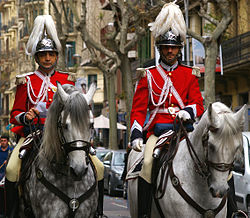Corps of Dragoons (Montecara): Difference between revisions
No edit summary |
No edit summary |
||
| Line 17: | Line 17: | ||
| nickname = | | nickname = | ||
| patron = | | patron = | ||
| motto = ''Legem servimus''<br>({{wp|Latin language|Solarian}}: We serve the law) | | motto = ''Legem servimus''<br>({{wp|Latin language|Solarian}}: "We serve the law") | ||
| colors = <!-- or | colours = --> | | colors = <!-- or | colours = --> | ||
| colors_label = <!-- or | colours_label = --> | | colors_label = <!-- or | colours_label = --> | ||
Revision as of 03:46, 3 January 2023
| Corps of Dragoons | |
|---|---|
| Corpo dei Dragòni | |
| Active | 1642–present |
| Country | |
| Role | Gendarmerie |
| Size | 5,139 (2020) |
| Motto(s) | Legem servimus (Solarian: "We serve the law") |
The Corps of Dragoons (Montecaran: Corpo dei Dragòni), commonly referred to simply as the Dragòni or Dragoons, is a gendarmerie force responsible for armed police duties in Montecara. The Dragoons are approximately equal to a brigadein size; their designation as a corps is for reasons of tradition and history.
The elite bodyguard unit of the Dragoons is the Squadron of Cuirassiers (Montecaran: Scuadròn di Coraçièri). It consists of approximately 300 elite dragoons tasked with protecting the most important people and buildings in Montecara. They are known for their brass helmets and breastplates as well as their strength and height, and can be seen in the background at most major state events.
History
There had long been a need for patrols in Montecara's hinterland to combat tax evasion and common crime. The Dragoons were established by Doxe Coràdo Muràca in 1642 to fulfill these needs. They were intended as a form of mounted infantry that would use their mounts to reach distant villages that would otherwise be beyond the routine reach of the state. Unfortunately for the citizens they patrolled, the Dragoons quickly earned a reputation for heavy-handed policing and for engaging in criminal behavior themselves, helping themselves to wine from inns and farms and harassing women. Efforts by the Doxe and state apparatus to instill discipline were only occasionally successful, but their dread reputation had its positive side as well. The most unruly members of the corps found themselves shipped off to the outlands of the Stado Ultramarìn on colonial duty, where their fearsome ways proved useful for keeping locals in check.


